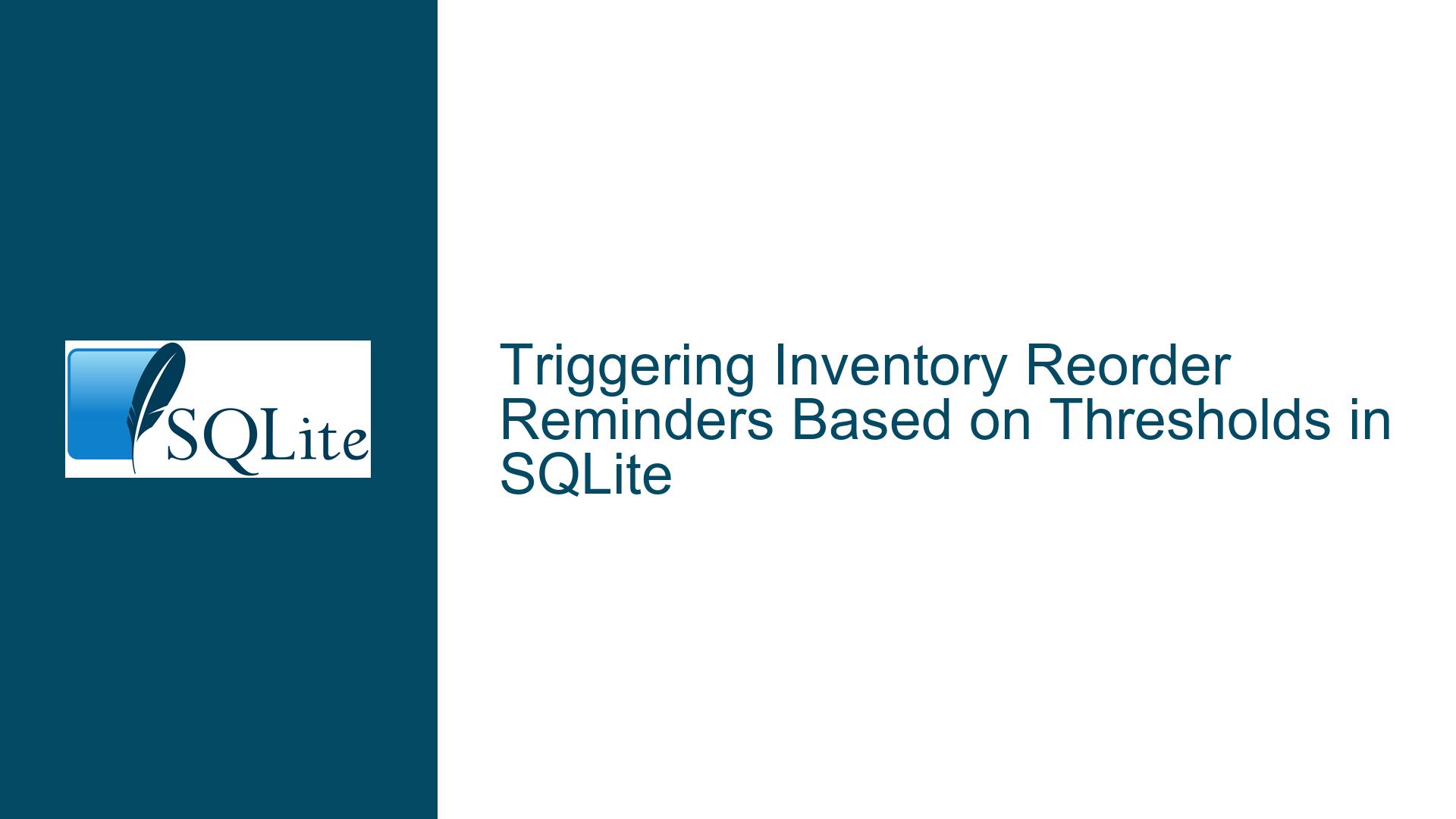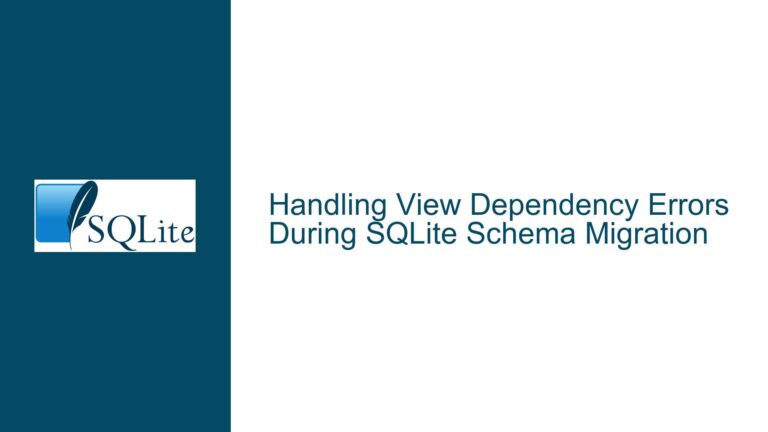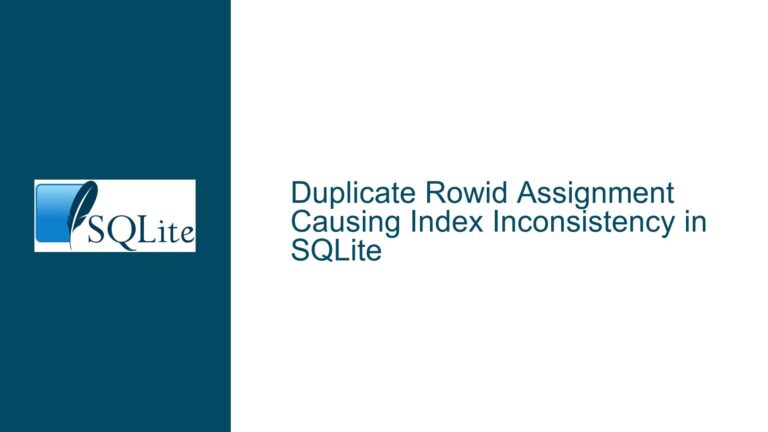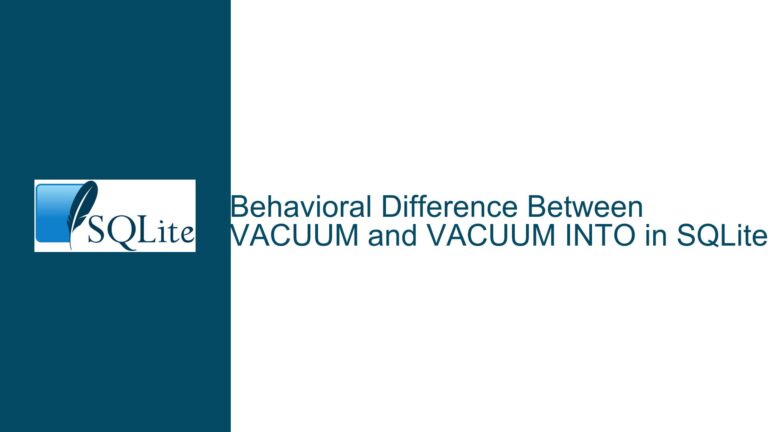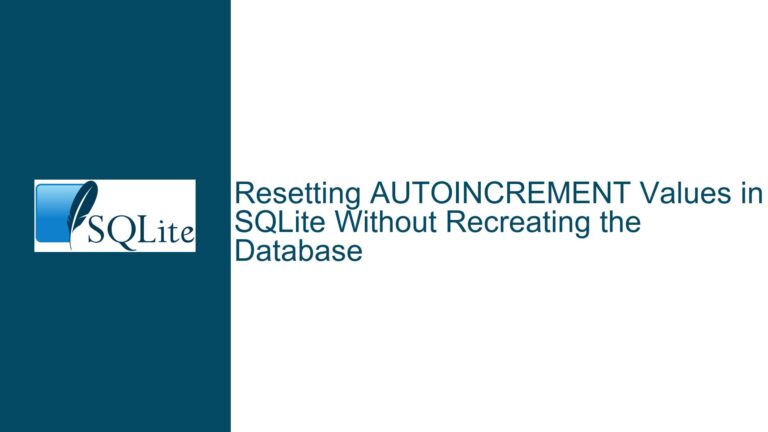Triggering Inventory Reorder Reminders Based on Thresholds in SQLite
Understanding Inventory Threshold Monitoring Requirements
The core challenge revolves around implementing an automated system to monitor stock levels in an SQLite database and trigger reorder reminders when inventory falls below predefined thresholds. This requires tracking two critical columns:
quantity(current stock count)min_quantity(minimum stock level before reordering is needed).
The goal is to create a reliable mechanism that detects when quantity <= min_quantity and communicates this state to the application layer or user. SQLite lacks built-in notification systems, so solutions must bridge database logic with external application workflows. Common pitfalls include misunderstanding SQLite’s constraints (no native event-driven reminders), conflating data storage with application logic, and handling transaction atomicity when triggering side effects like notifications.
Key Architectural and Operational Constraints in SQLite
1. Absence of Native Notification Mechanisms
SQLite does not support server-side processes, scheduled jobs, or asynchronous callbacks. Unlike client-server databases (e.g., PostgreSQL), it cannot actively "push" notifications to applications. All interactions are request-response: the application must initiate queries or updates. This necessitates a polling-based approach or leveraging SQLite’s extension mechanisms (e.g., triggers, hooks) to flag low-stock states within the database, which the application later detects.
2. Trigger-Based Side Effects and Transactional Risks
Triggers can execute logic after data changes, but directly invoking application-layer actions (e.g., sending emails, displaying dialogs) from triggers introduces risks:
- Transaction Blocking: If a trigger invokes a long-running operation (e.g., waiting for user confirmation), the transaction remains open, causing locks and concurrency issues.
- Failure Propagation: If a side effect fails (e.g., a network error during email delivery), the entire transaction could roll back, undoing the data change that triggered the reminder.
3. Data Modeling Limitations
The initial schema (stock table with quantity, min_quantity) lacks a dedicated column or table to track reorder states. Without this, calculating the "needs reorder" status requires real-time computation during queries. While generated columns or views can derive this state, they do not inherently persist it for external systems to act upon.
4. Application-Database Responsibility Boundaries
The choice between SQL-centric and application-centric logic hinges on:
- Immediacy: How quickly must reminders be acted upon?
- Decoupling: Should the database manage state transitions independently, or should the application handle them?
- Portability: Solutions relying on SQLite extensions (e.g., custom functions) may complicate migrations to other databases.
Implementing and Validating Threshold-Driven Reminder Systems
Solution 1: Trigger-Managed Notification Flags
Create a notification table to log reorder events and a trigger that inserts records into this table when stock falls below the threshold.
Step 1: Schema Modifications
CREATE TABLE stock (
product_id TEXT PRIMARY KEY,
quantity INTEGER NOT NULL DEFAULT 0,
min_quantity INTEGER NOT NULL DEFAULT 0
);
CREATE TABLE reorder_notification (
notification_id INTEGER PRIMARY KEY,
product_id TEXT NOT NULL,
generated_at TIMESTAMP DEFAULT CURRENT_TIMESTAMP,
acknowledged BOOLEAN DEFAULT 0,
FOREIGN KEY (product_id) REFERENCES stock(product_id)
);
Step 2: Trigger Implementation
CREATE TRIGGER check_reorder_threshold AFTER UPDATE ON stock
FOR EACH ROW
WHEN NEW.quantity <= NEW.min_quantity
BEGIN
INSERT INTO reorder_notification (product_id)
VALUES (NEW.product_id);
END;
Validation and Considerations:
- After updating
stock.quantity, checkreorder_notificationfor new entries. - Use
WHERE acknowledged = 0to fetch unprocessed notifications. - Acknowledge processed notifications with
UPDATE reorder_notification SET acknowledged = 1 WHERE notification_id = ?. - Advantages: Decouples detection from action; avoids blocking transactions.
- Risks: Requires application polling; duplicates may occur if updates happen repeatedly below the threshold.
Solution 2: Generated Column for Real-Time Status
Use a generated column to compute a reorder_status dynamically.
Step 1: Schema Definition
CREATE TABLE stock (
product_id TEXT PRIMARY KEY,
quantity INTEGER NOT NULL DEFAULT 0,
min_quantity INTEGER NOT NULL DEFAULT 0,
reorder_status TEXT GENERATED ALWAYS AS (
CASE WHEN quantity <= min_quantity THEN 'REORDER' ELSE 'OK' END
) VIRTUAL
);
Step 2: Querying for Reorder States
SELECT product_id, quantity, min_quantity
FROM stock
WHERE reorder_status = 'REORDER';
Validation and Considerations:
- Pros: No redundant storage; status updates automatically.
- Cons: Cannot index virtual generated columns; performance degrades with large datasets. Use
STOREDinstead ofVIRTUALif persistence is acceptable.
Solution 3: Update Hooks for Immediate Application Feedback
SQLite’s sqlite3_update_hook() allows C applications to register a callback invoked on row updates. While not directly accessible from pure SQL, Python’s sqlite3 module can approximate this using connection wrappers.
Python Example:
import sqlite3
class ReorderHook:
def __init__(self, conn):
self.conn = conn
self.conn.set_update_hook(self.on_update)
def on_update(self, operation, db_name, table_name, rowid):
if table_name == 'stock':
product_data = self.conn.execute(
"SELECT quantity, min_quantity FROM stock WHERE rowid = ?",
(rowid,)
).fetchone()
if product_data and product_data[0] <= product_data[1]:
print(f"Reorder needed for product ID {rowid}")
conn = sqlite3.connect('inventory.db')
hook = ReorderHook(conn)
Validation and Considerations:
- Pros: Near-real-time notifications without polling.
- Cons: Tied to a specific database connection; not persisted across sessions.
Solution 4: Materialized View with Polling
For complex joins across tables, create a view that aggregates stock data and computes reorder status.
Step 1: View Definition
CREATE VIEW stock_reorder_status AS
SELECT
s.product_id,
s.quantity,
s.min_quantity,
CASE WHEN s.quantity <= s.min_quantity THEN 'REORDER' ELSE 'OK' END AS status
FROM stock s;
Step 2: Application Polling Logic
import sqlite3
import time
def monitor_stock():
conn = sqlite3.connect('inventory.db')
while True:
reorders = conn.execute(
"SELECT product_id FROM stock_reorder_status WHERE status = 'REORDER'"
).fetchall()
for product in reorders:
send_reorder_alert(product[0])
time.sleep(60) # Poll every minute
Validation and Considerations:
- Pros: Simplifies query logic; works with normalized schemas.
- Cons: Polling interval introduces latency; view recalculates on each access.
Best Practices for Schema Design and Indexing
- Normalization: Store
min_quantityin a separateproduct_settingstable if it’s metadata unrelated to physical stock. - Indexing: Add indexes on
quantityandmin_quantityfor faster threshold checks:CREATE INDEX idx_stock_quantity ON stock(quantity); CREATE INDEX idx_stock_min_quantity ON stock(min_quantity); - Constraint Validation: Use
CHECKconstraints to prevent invalid states:CREATE TABLE stock ( ... CHECK (quantity >= 0), CHECK (min_quantity >= 0) );
Transactionally Safe Notification Handling
To avoid duplicate reminders and ensure reliability:
- Use Atomic Transactions: Wrap stock updates and notification inserts in a single transaction.
- Locking Strategies: Employ
SELECT ... FOR UPDATE(viaBEGIN IMMEDIATE) in polling loops to lock rows during notification processing. - Idempotency Tokens: Add a
uuidcolumn toreorder_notificationto deduplicate processing attempts.
Hybrid Approach: SQLite + Application Logic
Combine triggers for state tracking with application-layer schedulers:
- Flagging: Triggers update a
needs_reviewboolean in thestocktable. - Batch Processing: A nightly job selects flagged rows, queues reminders, and resets flags.
ALTER TABLE stock ADD COLUMN needs_review BOOLEAN DEFAULT 0;
CREATE TRIGGER flag_low_stock AFTER UPDATE ON stock
FOR EACH ROW
WHEN NEW.quantity <= NEW.min_quantity
BEGIN
UPDATE stock SET needs_review = 1 WHERE product_id = NEW.product_id;
END;
Error Handling and Logging
- Trigger Error Propagation: Use
RAISE(ABORT, ...)in triggers to enforce business rules (e.g., preventing stock from going negative). - Logging Table: Audit all stock changes and notification attempts:
CREATE TABLE audit_log ( log_id INTEGER PRIMARY KEY, event TEXT CHECK(event IN ('update', 'notification')), product_id TEXT, details TEXT, logged_at TIMESTAMP DEFAULT CURRENT_TIMESTAMP );
Final Recommendations
- For Simple Apps: Use a generated column + application polling.
- For High-Volume Systems: Opt for trigger-managed flags with indexed notification tables.
- For Real-Time Needs: Implement update hooks in the application layer.
By decoupling detection (SQL triggers/generated columns) from action (application logic), you balance SQLite’s simplicity with reliable reminder systems.
